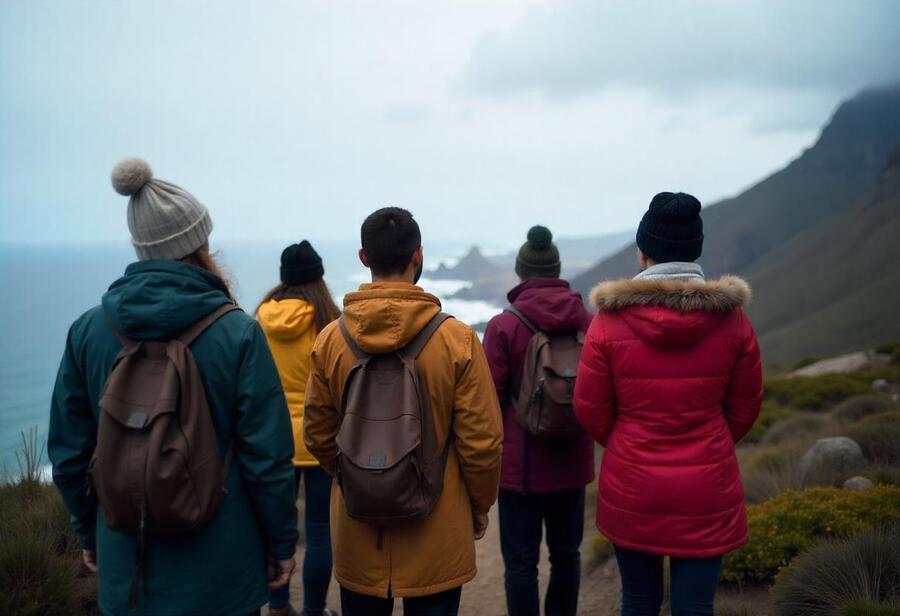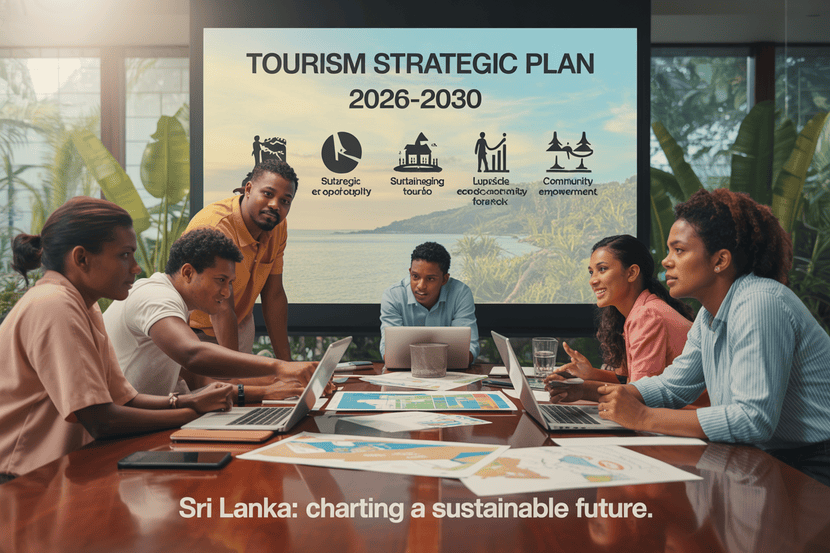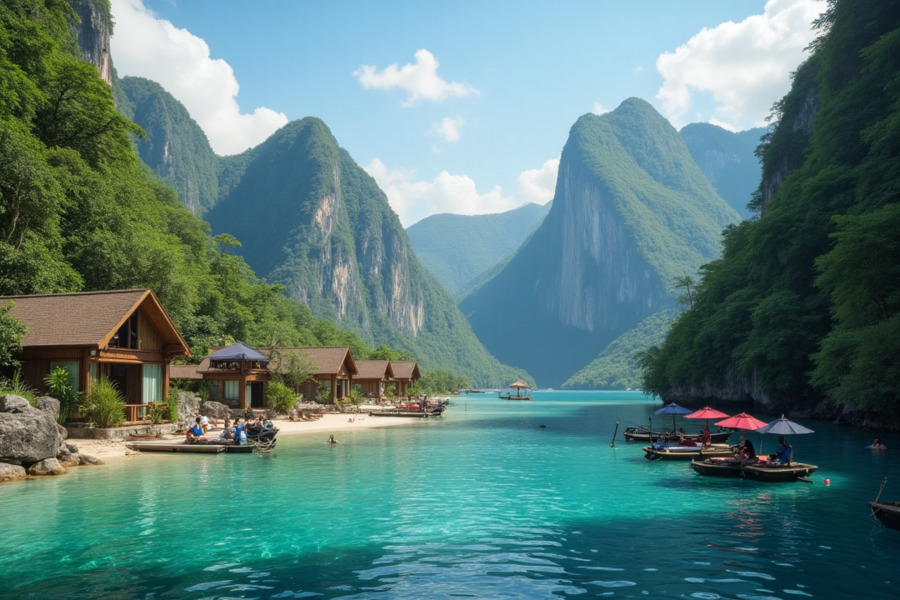≡-Rwanda United with South Africa, Morocco, Egypt, Tanzania, Kenya, Ghana, Botswana and More in Powering New Africa Tourism Boom with Record-Breaking Growth – Viral of Today
<> Viral of Today <>
Home » AFRICA » Rwanda United with South Africa, Morocco, Egypt, Tanzania, Kenya, Ghana, Botswana and More in Powering New Africa Tourism Boom with Record-Breaking Growth Tuesday, June 10, 2025Rwanda united with South Africa, Morocco, Egypt, Tanzania, Kenya, Ghana, Botswana, and more to power a new Africa tourism boom in 2024, as countries across the continent recorded historic surges in international arrivals, tourism revenue, and job creation. This wave of record-breaking growth was driven by a mix of strategic government investments, expanded air connectivity, targeted marketing campaigns, and a strong emphasis on sustainability and local impact. From Rwanda’s conservation-led experiences to Morocco’s early achievement of its 2030 visitor goals, and from Ghana’s cultural homecomings to Botswana’s eco-tourism excellence, each nation brought its own strengths to the forefront. Together, they transformed Africa into one of the most exciting and resilient travel regions in the world, setting a new standard for purpose-driven tourism growth.Rwanda Leads With Vision, Breaking All Tourism Records in 2024Rwanda surged ahead in 2024 as one of the standout leaders of Africa’s tourism revival, hitting historic highs in every major category. The country’s Travel & Tourism sector generated a record-breaking Fr1.9 trillion, making up 9.8% of the national economy, and exceeding its previous peak by a striking 17.7%. This remarkable achievement wasn’t by chance—it was the result of years of strategic planning and bold investment.International visitor spending soared to Fr1 trillion, while domestic spending jumped 32.2% above pre-pandemic levels, reaching Fr773 billion. The total number of tourism-supported jobs climbed to just under 386,000, showing Rwanda’s commitment to making tourism a pillar of both economic growth and inclusive employment.Looking ahead, Rwanda is poised to climb even higher. In 2025, the sector is expected to contribute Fr2.1 trillion to GDP and support more than 402,000 jobs. A key part of this momentum is the country’s high-value, low-volume tourism model, which focuses on sustainability, conservation, and local benefits. Experiences like gorilla trekking in Volcanoes National Park and eco-tourism across Akagera and Nyungwe continue to attract discerning travelers.And with the upcoming Bugesera International Airport set to handle 14 million passengers annually, Rwanda is preparing to welcome the future of African tourism on its own terms—sustainably, strategically, and at full strength.Rwanda – Kigali, Musanze (Volcanoes), NyungweKigaliKigali is Rwanda’s peaceful and progressive capital, known for its cleanliness, order, and emerging creative scene. It’s a city of quiet resilience and ambition, where history, healing, and innovation meet. Kigali serves as the heart of the country’s cultural revival and a perfect introduction to Rwanda’s modern identity.Things to do: Take a guided city tour through the Nyamirambo neighborhood, shop for colorful baskets and fabrics at Kimironko Market, and enjoy fresh Rwandan coffee at one of the city’s many cafés.Places to visit: Kigali Genocide Memorial, Inema Arts Center, Campaign Against Genocide Museum, and Mount Kigali.Must-visit experiences: Reflect at the Genocide Memorial, then take in the city’s lush hills from a rooftop restaurant as the sun sets over Kigali.Musanze (Volcanoes National Park)Musanze is the gateway to Rwanda’s crown jewel—Volcanoes National Park, home of the endangered mountain gorillas. The town is small but buzzing with eco-tourism activity and surrounded by volcano views and rolling green hills.Things to do: Go gorilla trekking with expert guides, visit Iby’Iwacu Cultural Village for an interactive look at Rwandan traditions, and explore local markets.Places to visit: Volcanoes National Park headquarters, Twin Lakes (Burera and Ruhondo), and Dian Fossey’s Karisoke Research Center.Must-visit experiences: Standing quietly just meters away from a gorilla family in the forest—an encounter that stays with travelers for life.Nyungwe ForestNyungwe National Park is one of Africa’s oldest rainforests and one of the most biologically rich environments on the continent. It’s ideal for travelers seeking peace, nature, and active exploration.Things to do: Take the canopy walk above the treetops, go chimpanzee trekking, and hike to waterfalls within the forest trails.Places to visit: Uwinka Visitor Center, Kamiranzovu Swamp, and Gisakura Tea Estate.Must-visit experiences: Walking 70 meters above the forest floor on the suspended canopy bridge and listening to the morning call of colobus monkeys in the treetops.South Africa Reclaims Momentum with Resilient Visitor Numbers and Domestic StrengthSouth Africa firmly reestablished itself in 2024 as a cornerstone of the African tourism revival, welcoming 8.92 million international visitors—a notable jump from the previous year and a strong sign of renewed global confidence in the country’s travel offerings. From the pulse of Cape Town’s coastlines to the safari-rich heartlands of Kruger and Addo, South Africa pulled tourists back in with its diverse landscapes, rich culture, and world-class experiences.But it wasn’t just international travelers who made the difference. South Africans themselves took to the roads and skies, pushing domestic travel to record levels, fueling hotels, restaurants, and heritage sites throughout the country. Bed occupancy soared, and spending from local travelers reached new highs, playing a crucial role in sustaining thousands of small and medium businesses across all nine provinces.Although international visitor spending hasn’t yet surpassed pre-pandemic benchmarks, South Africa’s tourism sector made powerful strides toward full recovery. The industry continued to support a massive share of the workforce and played a central role in job creation, especially in rural communities and emerging tourism corridors.With continued investment in infrastructure, cultural events, and safety enhancements, South Africa is not just bouncing back—it’s setting the pace for a modern, inclusive, and resilient travel economy. As global interest rises ahead of upcoming major events and eco-tourism drives, South Africa stands ready to anchor the new Africa tourism boom with pride and purpose.South Africa – Cape Town, Johannesburg, KrugerCape TownCape Town is one of the world’s most breathtakingly beautiful cities, framed by mountains, vineyards, and sea. It’s cosmopolitan, relaxed, and bursting with culture, history, and creativity. Whether you’re exploring the city or its surroundings, Cape Town offers something for every kind of traveler.Things to do: Ride the cable car up Table Mountain, taste your way through the Cape Winelands, and stroll the colorful Bo-Kaap district.Places to visit: Robben Island, V&A Waterfront, Kirstenbosch Botanical Gardens, and Camps Bay.Must-visit experiences: Watching the sun set over the ocean from Signal Hill and walking among penguins at Boulders Beach.JohannesburgJohannesburg, or Jozi, is South Africa’s largest city and economic heart, full of contrast and charisma. It’s where you’ll find powerful museums, buzzing arts districts, and deep cultural storytelling rooted in both pain and triumph.Things to do: Visit the Apartheid Museum, take a guided tour of Soweto, and explore street art and coffee shops in Maboneng.Places to visit: Constitution Hill, Mandela House, the Hector Pieterson Memorial, and Gold Reef City.Must-visit experiences: Walking Vilakazi Street, the only street in the world to have housed two Nobel Peace Prize winners—Nelson Mandela and Desmond Tutu.Kruger National ParkKruger is one of Africa’s top safari destinations, spanning nearly 20,000 square kilometers of wilderness teeming with wildlife. Whether you choose a self-drive or luxury lodge experience, Kruger delivers unforgettable moments with nature.Things to do: Go on guided game drives, enjoy sunset drinks in the bush, and take a walking safari with trained rangers.Places to visit: Skukuza and Lower Sabie rest camps, Panorama Route attractions (like God’s Window and Blyde River Canyon), and the Crocodile Bridge Gate.Must-visit experiences: Spotting all of the Big Five—lion, leopard, rhino, elephant, and buffalo—in a single day and sleeping under the stars in a luxury tented camp.Morocco Smashes Visitor Records and Fast-Tracks Toward 2030 Tourism GoalsMorocco stole the spotlight in 2024 with a record-setting performance that positioned it among Africa’s top tourism powerhouses. The country welcomed a historic 17.4 million international tourists, shattering all previous records and achieving its 2030 goal six years ahead of schedule. This wasn’t just a rebound—it was a transformation.Backed by aggressive digital campaigns, infrastructure upgrades, and a refined strategy to attract new markets, Morocco’s tourism engine ran at full speed. From the maze-like alleys of Fes to the breezy beaches of Essaouira, the country delivered on every front—culture, coastline, and culinary experiences. Iconic sites like Marrakech’s medina and the blue-hued charm of Chefchaouen saw foot traffic like never before, while newer destinations such as Dakhla gained global attention among adventure and wellness travelers.The impact was more than just visitor numbers. Morocco’s tourism revenue climbed to 104 billion dirhams, contributing roughly 7% to the national GDP and generating employment across hospitality, crafts, and transportation. Local economies, especially in heritage-rich rural areas, felt the windfall as Morocco capitalized on its appeal as a safe, affordable, and visually stunning destination.Looking forward, Morocco is sharpening its focus on sustainable tourism, with plans to balance mass appeal with ecological and community-focused travel. As the country prepares to co-host the 2030 FIFA World Cup, its tourism future looks brighter than ever. Morocco has not only joined the new Africa tourism boom—it’s accelerating it.Morocco – Marrakech, Fes, Chefchaouen, CasablancaMarrakechMarrakech is Morocco’s beating heart—a city that blends centuries of tradition with modern flair. Within the ancient walled Medina, you’ll find vibrant souks, Islamic architecture, and palaces full of intricate tilework. The atmosphere is lively, colorful, and sometimes chaotic—but always memorable.Things to do: Wander the maze-like alleys of the Medina, take a cooking class using local spices, and relax in a traditional Moroccan hammam.Places to visit: Bahia Palace for its stunning design, Jardin Majorelle for calm and color, and the Koutoubia Mosque for its architectural grandeur.Must-visit experiences: Spend an evening at Jemaa el-Fnaa Square, where snake charmers, storytellers, and sizzling food stalls light up the night.FesOften described as Morocco’s cultural capital, Fes is home to one of the oldest universities in the world and a medina that has changed little in centuries. Unlike Marrakech, Fes is more conservative and deeply rooted in scholarly tradition. Its narrow alleyways transport you into a world of artisans, madrasas, and hidden courtyards.Things to do: Take a guided walking tour of the Fes el-Bali Medina, visit local pottery workshops, and learn the history of Islamic scholarship.Places to visit: Al Quaraouiyine Mosque and University, Bou Inania Madrasa, and the Chouara Tannery.Must-visit experiences: Watching leather being dyed in sunken pits at the tanneries while overlooking the medina from a balcony above.ChefchaouenTucked into the Rif Mountains, Chefchaouen is one of the most photogenic towns in the world, known for its vivid blue-painted walls and laid-back energy. It’s a favorite among photographers, hikers, and anyone looking for a peaceful escape from Morocco’s busier cities.Things to do: Walk through the winding blue alleyways, hike to the Spanish Mosque for sunset views, and explore local art galleries.Places to visit: Plaza Uta El Hammam, Ras El Maa Waterfall, and the Kasbah Museum.Must-visit experiences: Sipping mint tea on a terrace while overlooking the entire blue-washed town in the evening light.Egypt Surpasses Expectations with Soaring Arrivals and Historic Revenue GainsEgypt delivered one of its most powerful tourism years to date in 2024, welcoming 15.7 million international visitors and generating a staggering $14.1 billion in tourism revenue. With the pyramids standing tall and the Nile flowing strong, the country not only met but exceeded expectations, cementing its position as a leading force in Africa’s travel revival.From the Red Sea resorts of Hurghada and Sharm El Sheikh to the ancient wonders of Luxor and Aswan, Egypt offered visitors a rare mix of timeless heritage and modern leisure. Enhanced safety protocols, expanded air connectivity, and aggressive promotional campaigns helped reignite global interest. But perhaps the biggest game-changer was the long-anticipated Grand Egyptian Museum, which began drawing attention even before its official opening, setting the stage for a new era of cultural tourism.This surge in demand also had a ripple effect across Egypt’s economy. Thousands of new jobs were created, local businesses reported record sales, and regional airports saw unprecedented traffic. Tourism’s contribution to the national economy strengthened visibly, supporting livelihoods in both urban and rural zones.Egypt’s 2024 success story is no fluke—it’s the result of targeted planning and strategic partnerships. With major events, cruise expansion along the Nile, and luxury travel gaining traction, the country is preparing for even bigger years ahead. Egypt isn’t just part of Africa’s new tourism boom—it’s helping define it.Egypt – Cairo, Luxor, Sharm El SheikhCairoCairo is Egypt’s energetic capital and one of the most historically rich cities in the world. This sprawling metropolis sits on the banks of the Nile and seamlessly blends ancient wonders with modern chaos. It’s the gateway to the Pyramids of Giza, but the city offers much more—from bustling markets to Islamic architecture and world-class museums.Things to do: Explore the backstreets of Islamic Cairo, sail on a traditional felucca boat at sunset, and shop for spices and souvenirs in Khan el-Khalili bazaar.Places to visit: The Egyptian Museum (soon to be replaced by the Grand Egyptian Museum), the Citadel of Saladin, and Al-Azhar Mosque.Must-visit experiences: Stand in awe before the Pyramids of Giza and the Sphinx, then cap it off with a rooftop dinner overlooking the glowing city skyline.LuxorOften called the world’s greatest open-air museum, Luxor lies along the Nile in southern Egypt and is home to many of the country’s most spectacular ancient monuments. The city is split by the river: the East Bank houses the temples and markets, while the West Bank hides tombs of pharaohs in the desert hills.Things to do: Take a hot air balloon ride at sunrise, walk through Luxor Temple at night, and cruise the Nile in a traditional sailboat.Places to visit: Karnak Temple, the Valley of the Kings, and Hatshepsut’s Temple.Must-visit experiences: Descend into the vividly painted tomb of Tutankhamun and watch the sun light up Karnak’s massive columns in the early morning.Sharm El SheikhSharm El Sheikh is Egypt’s premier beach destination, located on the Sinai Peninsula along the Red Sea. Known for its clear turquoise waters and coral reefs, the town offers both relaxation and adventure. It’s a favorite among divers, beachgoers, and travelers looking for luxury resorts.Things to do: Go snorkeling or diving at Ras Mohammed National Park, ride camels in the Sinai Desert, and enjoy nightlife along Naama Bay.Places to visit: Soho Square for entertainment, Al Sahaba Mosque, and the Old Market for local crafts and spices.Must-visit experiences: Scuba dive or snorkel over the reef walls at Shark’s Bay or Blue Hole, and take a jeep safari into the desert for stargazing.Tanzania Breaks Through with Historic Tourist Numbers and Nature-Driven DemandTanzania roared into the spotlight in 2024 with a record-breaking 5.36 million tourist arrivals, comfortably surpassing its original 2025 goal an entire year early. This phenomenal growth underscored the country’s rising status as one of Africa’s top destinations for nature lovers, adventure seekers, and culture-focused travelers alike.What drew the world to Tanzania in such large numbers? A big part of the answer lies in the country’s incredible natural offerings—Mount Kilimanjaro, the Serengeti, and Zanzibar’s pristine beaches. From wildlife safaris during the Great Migration to spice tours on the Indian Ocean coast, Tanzania offered visitors authentic and unforgettable experiences at every turn.This success wasn’t accidental. The government ramped up investments in air connectivity, streamlined visa processes, and prioritized sustainable tourism development in national parks and coastal zones. As a result, tourism revenue soared, with the industry contributing more jobs, higher local income, and greater foreign exchange earnings than at any point in the country’s history.Equally important is Tanzania’s strong commitment to conservation. The country continues to champion low-impact, eco-conscious tourism, protecting its biodiversity while ensuring that communities living near protected areas directly benefit from tourism’s growth.With international partnerships expanding and luxury tourism projects underway, Tanzania is firmly entrenched in the heart of Africa’s new tourism boom—and it’s doing it on its own terms, with nature, heritage, and resilience leading the way.Tanzania – Arusha, Serengeti, ZanzibarArushaArusha is Tanzania’s safari capital, sitting at the foot of Mount Meru and serving as the launch point for adventures to the Serengeti, Ngorongoro Crater, and Mount Kilimanjaro. The city itself is lively and bustling, with markets, museums, and coffee farms all within reach.Things to do: Explore the Maasai Market, visit the Cultural Heritage Centre, and take a day tour of nearby coffee plantations.Places to visit: Arusha National Park, Meserani Snake Park, and the Natural History Museum.Must-visit experiences: Standing on the rim of Ngorongoro Crater or catching a glimpse of Mount Kilimanjaro on a clear morning drive out of town.Serengeti National ParkThe Serengeti is one of the most iconic safari destinations on Earth, famous for the Great Migration and its vast, endless plains filled with wildlife. It’s where travelers come to witness raw nature in motion.Things to do: Go on sunrise and sunset game drives, take a hot air balloon over the plains, and enjoy bush dinners under the stars.Places to visit: Seronera Valley for big cat sightings, Grumeti River during migration season, and Olduvai Gorge for archaeological history.Must-visit experiences: Witnessing a river crossing during the wildebeest migration or spotting the Big Five in a single day with a local guide.Zanzibar (Stone Town and Beaches)Zanzibar is Tanzania’s island escape, a tropical paradise known for its white-sand beaches and Stone Town’s winding alleys. A visit here adds relaxation and spice to any Tanzanian itinerary.Things to do: Swim and snorkel off the coast, take a spice tour inland, and wander the historic alleys of Stone Town.Places to visit: Prison Island, Forodhani Night Market, and Jozani Forest.Must-visit experiences: Watching the sun set over the Indian Ocean from a rooftop café in Stone Town and snorkeling at Mnemba Atoll.Kenya Rebounds Stronger with Surging Hotel Demand and Rising Visitor SpendKenya solidified its place in Africa’s tourism resurgence in 2024 by delivering a year of powerful recovery and promising momentum. The country recorded over 9.9 million hotel bed-nights, with occupancy rising by 16%, showing a clear return of both international and domestic travelers eager to experience the magic of Kenya.From the world-famous Maasai Mara to the white-sand beaches of Diani, Kenya offered a blend of thrilling safaris, cultural richness, and coastal escapes that kept travelers coming back. Nairobi and Mombasa both saw boosts in conference tourism and air traffic, while national parks reported increased gate entries and higher spend per visitor.The tourism sector didn’t just rebound—it evolved. Kenya’s government pushed for increased digital marketing, upgraded tourism infrastructure, and rolled out plans to expand direct international flights to new markets in Asia, Europe, and the Gulf. The result? A noticeable rise in visitor spend and a more diversified traveler base.Tourism earnings surged and are projected to reach KES 650 billion (around USD 5 billion) in 2025, creating jobs, boosting small businesses, and breathing life into local economies across the country. The ripple effect has been especially felt in rural communities and among youth-led startups in ecotourism, guiding, and local crafts.With a firm eye on sustainability and a renewed commitment to security, conservation, and innovation, Kenya is not just part of Africa’s tourism revival—it’s helping shape what comes next.Kenya – Nairobi, Maasai Mara, MombasaNairobiNairobi is Kenya’s capital and one of Africa’s most dynamic cities. It offers a fast-paced urban experience balanced by unexpected proximity to wildlife—Nairobi National Park sits just outside the city center.Things to do: Visit the Giraffe Centre and Elephant Orphanage, explore local fashion and food in Karen, and take a city walking tour.Places to visit: Nairobi National Park, the Nairobi Railway Museum, and the Karen Blixen Museum.Must-visit experiences: Watching wild lions roam with a city skyline in the background, then dining at one of Nairobi’s farm-to-table restaurants.Maasai MaraMaasai Mara is one of the world’s most famous safari destinations and the Kenyan side of the Serengeti ecosystem. Known for the annual wildebeest migration and rich Maasai culture, it delivers unforgettable wildlife encounters.Things to do: Go on full-day game drives, visit Maasai villages, and take a sunrise hot air balloon ride over the savannah.Places to visit: Talek Gate and Mara Triangle for prime game viewing.Must-visit experiences: Watching a lion hunt during golden hour or witnessing the migration river crossings between July and October.MombasaMombasa is Kenya’s coastal hub, steeped in Swahili culture and defined by warm beaches, coral reefs, and centuries of Indian Ocean trade history. It’s a laid-back contrast to Nairobi and a popular getaway spot.Things to do: Explore Old Town’s Arab architecture, relax at Diani Beach, and snorkel in the Kisite-Mpunguti Marine Park.Places to visit: Fort Jesus, Haller Park, and Mombasa Marine National Park.Must-visit experiences: Wandering the narrow streets of Old Town at sunrise and taking a dhow cruise at sunset along the coastline.Ghana Draws Global Crowds with Culture-Led Campaigns and Diaspora Tourism HighsGhana emerged as a cultural heavyweight in Africa’s tourism comeback in 2024, capturing international attention through strategic events, compelling storytelling, and a powerful connection to the African diaspora. The country welcomed significantly more international visitors compared to the previous year, driven by bold seasonal campaigns and rising demand for heritage-based travel.The biggest star of the year? “Detty December.” The end-of-year cultural explosion turned Accra into one of the most sought-after destinations in the world for music, fashion, art, and Afro-Caribbean reunions. Thousands flocked to the capital for back-to-back festivals, performances, and curated cultural experiences—driving hotel bookings, event ticket sales, and airline traffic to record highs. Visitor arrivals soared, and flights increased by over 45% from key global markets.Tourism earnings also surged by nearly 18%, energizing the country’s economy and creating new opportunities in hospitality, entertainment, transportation, and local entrepreneurship. For many returning members of the African diaspora, the visit was more than a holiday—it was a homecoming, woven with emotional connection and cultural pride.Ghana’s tourism strategy in 2024 emphasized more than just volume. The government and private sector worked closely to promote investment in eco-tourism, digital tourism platforms, and the restoration of key historical sites. From the Cape Coast Castle to immersive community tours in the Volta and Northern regions, Ghana showed that heritage and innovation can go hand in hand.As the country now looks toward long-term development of year-round tourism zones, Ghana stands firmly united with Africa’s top performers—driving a new kind of tourism boom, grounded in identity, creativity, and pride.Ghana – Accra, Cape Coast, KumasiAccraAccra is Ghana’s energetic capital and cultural heartbeat, blending African heritage with contemporary arts, music, and politics. The city thrives on contrast—beachfronts and tech hubs, historic forts and rooftop bars, all coexisting in a fast-paced urban rhythm.Things to do: Visit the bustling Makola Market, enjoy Ghanaian cuisine at Osu Night Market, and experience Accra’s vibrant nightlife in Labone or East Legon.Places to visit: Kwame Nkrumah Mausoleum, W.E.B. DuBois Center, and Independence Arch.Must-visit experiences: Dancing to Afrobeats at a beachfront club after sunset and browsing local art at the Arts Centre for National Culture.Cape CoastCape Coast is a historic coastal city where Ghana’s deep, painful ties to the transatlantic slave trade come into focus. Today, it’s a place for reflection, education, and cultural renewal.Things to do: Take a guided tour of Cape Coast Castle, walk the canopy bridges of Kakum National Park, and stroll the fishing harbors.Places to visit: Elmina Castle, Cape Coast Castle Museum, and the Asafo Shrines.Must-visit experiences: Standing inside the “Door of No Return” and learning the stories that shaped the African diaspora.KumasiAs the former capital of the Ashanti Kingdom, Kumasi offers deep cultural pride and a strong connection to Ghanaian identity. The city is known for its royal heritage, woodcarving, and the largest open-air market in West Africa.Things to do: Visit the Kejetia Market, attend a traditional Ashanti ceremony, and explore local craft villages.Places to visit: Manhyia Palace Museum, Kumasi Cultural Centre, and Lake Bosomtwe.Must-visit experiences: Watching kente weavers at work in Bonwire and experiencing the storytelling traditions of Ashanti elders.Botswana Elevates Its Eco-Tourism Model as Global Demand for Wilderness Escapes SurgesBotswana quietly delivered one of Africa’s most impactful tourism comebacks in 2024, drawing in high-value travelers from across the globe seeking exclusivity, sustainability, and untouched wilderness. Known for its commitment to conservation-first tourism, Botswana doubled down on its low-volume, high-impact model—and the results spoke volumes.Visitor arrivals climbed steadily throughout the year, driven by renewed interest in the Okavango Delta, Chobe National Park, and the remote, soul-stirring landscapes of the Kalahari. Luxury safari operators reported record bookings, particularly from European, North American, and Australian markets, where travelers sought meaningful, eco-conscious alternatives to mass tourism.What sets Botswana apart is how deeply its tourism success is tied to environmental stewardship and community empowerment. In 2024, eco-tourism revenue not only rose, but so did its share in supporting local livelihoods, conservation jobs, and anti-poaching programs. Many safari camps and lodges across the country now operate under co-ownership or partnership models with indigenous communities, ensuring that tourism profits flow directly to the people living closest to the land.Government support for green tourism remained strong throughout the year, with initiatives to promote solar-powered camps, limit tourist density in fragile ecosystems, and expand protected areas. These efforts were rewarded with global recognition, and Botswana’s tourism sector is now widely seen as a blueprint for how Africa can grow tourism without compromising its ecological soul.In 2024, Botswana didn’t chase crowds—it curated experiences. And in doing so, it secured its position as one of the most respected and resilient players in Africa’s new tourism boom.Botswana – Maun, Okavango Delta, ChobeMaunMaun is the gateway to Botswana’s wilderness and a growing destination in its own right. It’s a laid-back safari town where travelers organize trips into the Delta, and where luxury lodges sit beside traditional cattle posts.Things to do: Visit local craft cooperatives, enjoy riverfront dining, and explore the town’s small but informative museums.Places to visit: Nhabe Museum, local basket-weaving centers, and Maun Game Reserve.Must-visit experiences: Taking a scenic flight over the Okavango Delta before heading into the bush on a guided safari.Okavango DeltaThe Okavango Delta is Botswana’s crown jewel—a UNESCO-listed inland delta where water meets desert, and wildlife thrives. It’s one of Africa’s most unique ecosystems and a dream for nature lovers.Things to do: Glide through lily-filled channels in a mokoro canoe, track wildlife on foot with expert guides, and stay in remote eco-camps.Places to visit: Moremi Game Reserve, Chief’s Island, and the seasonal floodplains.Must-visit experiences: Hearing elephants trumpet near your tent and watching lions stalk prey through the grasslands from a 4×4.Chobe National ParkLocated in northern Botswana, Chobe is famous for its massive elephant herds and boat-based safaris along the Chobe River. It’s ideal for travelers who want dramatic wildlife encounters in a more accessible setting.Things to do: Take a sunset cruise on the Chobe River, join early morning game drives, and photograph hippos and crocs from the riverbanks.Places to visit: Chobe Riverfront, Kasane town, and Sedudu Island.Must-visit experiences: Watching hundreds of elephants gather at the water’s edge during dry season and cruising past pods of hippos at eye level.Rwanda united with South Africa, Morocco, Egypt, Tanzania, Kenya, Ghana, Botswana, and others in driving a record-breaking tourism boom across Africa in 2024, fueled by historic visitor numbers, rising revenue, bold government investment, and a shared commitment to sustainable, experience-led travel.Africa’s Tourism Revival Sets a New Global Benchmark for Growth and PurposeFrom the mountain trails of Rwanda to the desert oases of Morocco, the beaches of Kenya to the wild heart of Botswana, Africa’s tourism story in 2024 was nothing short of transformational. Countries across the continent didn’t just bounce back—they redefined what a modern, sustainable, and inclusive tourism boom can look like.Each destination brought something unique to the table: Rwanda led with vision and conservation, Morocco dazzled with record arrivals, Egypt anchored itself in heritage and scale, and South Africa reconnected communities through strong domestic travel. Tanzania hit record milestones in nature-based tourism, while Kenya rose with strong hotel demand and growing global curiosity. Ghana stood tall as a cultural beacon for the African diaspora, and Botswana showcased the power of preserving wilderness while lifting up local communities.This wasn’t a one-off rebound—it was a collective, strategic movement. Governments invested, the private sector innovated, and travelers responded with enthusiasm and trust. Together, these countries proved that Africa is not only capable of powering a global tourism boom, but of doing it in a way that prioritizes sustainability, local prosperity, and long-term resilience.As 2025 unfolds, the message is clear: Africa isn’t just back on the travel map—it’s leading it forward.Tags: Botswana, Egypt, ghana, kenya, morocco, Rwanda, South Africa, Tanzania, Tourism news, travel industry, Travel News
This information will surprise you!
See also
- Read until the end to discover everything.
- Important information you need to know.
- Interesting facts and helpful tips.
Conclusion
Did you enjoy the news? Keep following us daily!













